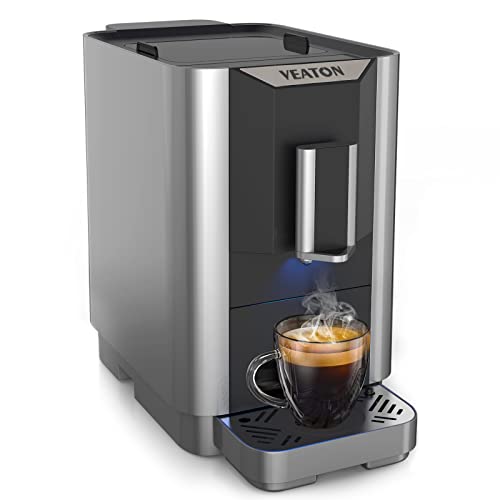Coffee and Espresso Machines

Espresso machines use pressure in order to make water into finely ground and tamped beans. They make a rich, delicious cup of coffee.
Good Housekeeping Institute experts recommend models that use a minimum of 9 bars to ensure an ideal extraction. Beware of brands who claim to use more pressure than necessary.
Types
The espresso maker (also known as a coffee or Espresso maker) creates coffee that is more concentrated, of higher quality, than your favorite cafe drinks. It utilizes an average of nine bars of pressure. These machines are equipped with many features, such as the control of temperature and brew strength with programmable brewing as well as multiple drink sizes. They could also have steam wands, either manual or automated, to create an latte with a texturized milk. They can be found in three major kinds of espresso machines, which include semi-automatic and automatic and super-automatic models. Each espresso machine has its own degree and type of automation.
Semi-automatic espresso machines are the most popular choice for specialty coffee shops. Semi-automatic espresso machines give baristas complete control over the brewing process, but are not as user friendly as fully automatic or automated machines. To get the most perfect espresso, you have to grind the beans, then fill the portafilter, then tamp it down, then adjust the extraction time.
Automatic machines come with an integrated mill that can measure and make sure your grounds are tamp. They automatically disperse the proper amount of water needed to extract the espresso, and they often come with a programmable drink size function. In our laboratory tests, they were the most well-liked kind of espresso machine. They offer a great combination of control and consistency.
Functions
You'll need a reservoir to hold the water you need to make coffee, whether you select a steam-driven or pump-driven machine. There's a heating element that heats the water to create the pressure needed to extract the coffee from the grounds.
When the button to brew is hit when the button is pressed, the valve that lets water into the brew chamber is closed to ensure that only hot water under high pressure can pass through the portafilter and into the ground coffee. The water takes approximately 25 seconds before it turns into espresso.
The insulated tubing called the hot-water tube is affixed from the reservoir to the spout at the top of your machine. portable espresso machine heating element that resists is responsible for heating the water as the water passes through the aluminum tube and metal warming plate.
After the spout has been turned on, place your cup underneath the spout to ensure that espresso flows into your cup through the portafilter. The coffee maker is also likely to include a steam wand which you can use to heat and froth milk to make drinks made with espresso, like cappuccino or latte.
Automatic machines eliminate the guesswork from brewing. They have a one-button operation They can be programmed, and they grind and measure beans for you and grind them down. In our Lab tests, they tend to perform best due to their being user-friendly and don't require an extensive amount of user expertise.
Materials
The inside of an espresso machine is a collection of copper tubes, boilers made of stainless steel, as well as intelligent firmware. Although they appear to be complex but their primary function is to convert hot water into finely ground coffee.
When you are looking for an espresso maker, think about the dimensions and space requirements, beverage options, energy-saving alternatives, and brewing precision. Also, look for a steam knob to activate the steam wand for frothing milk and creating latte art. A pressure gauge on the front of the machine will let you know the boiler's and pump's operating pressure. It is recommended to look for an espresso machine with two needles to see the minimum and maximum pressure.
If you're looking to make more than espresso, select a machine that has different brew sizes, including ristretto. There are models that have a removable frothing hopper that allows for hassle-free, hands-free frothing. You can also switch between various kinds of milk easily. If you have hard water, opt for a model with a built-in softener to avoid mineral build-up and keep your espresso tasting fresh.
Some manufacturers use a thermostat that is digital integral and proportional, to ensure an appropriate temperature range when brewing espresso. This feature allows for the same high-quality, consistent cup of espresso each time. It also saves on energy costs since the machine only operates when it's needed.
Maintenance
The care and maintenance of espresso and coffee machines is becoming more crucial as they become more available to home use. The right equipment can make a world of difference to your cup of coffee, but that's only true if your machine is in good working order.
Regular maintenance and cleaning needs to consist of everything from cleaning the steam wand, group head and water filter to decaling and changing the water filters on a regular basis. As a rule of thumb that you make between two and five cups of coffee each day, you should wash most parts of the machine every week. Some parts of the machine will require cleaning every two to three weeks, for instance, the water tank and grinder.
You should also backflush the machine each week. This involves sealing the portafilter and running the brew cycles several times. This can help to eliminate any stray coffee grounds or oils left behind. You can also use a brush or cleaner specifically designed for espresso machines to clean the portafilter.
Maintaining your coffee and espresso machine properly can ensure that it lasts longer. A lot of professional espresso machines found in cafes and offices are costly, so it is crucial to ensure that your machine is in good condition to last as long as is possible.
